All about Spitz dogs
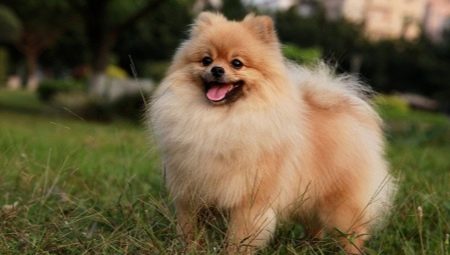
Spitz occupy a special place among dog lovers. Companion dogs, whose origins date back millennia, have a variety of appearances that make them seem like fluffy toys. The material of this article is intended to help the reader find answers to questions of interest regarding dogs of this breed. We will consider a description of animals, their main varieties, dwell on the nature of pets, as well as the nuances of their maintenance and breeding.
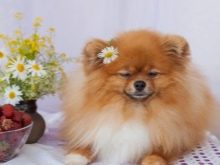

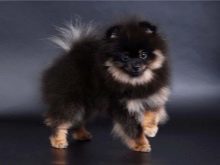
Origin story
The history of the origin of Spitz is rather controversial and has many legends. According to one version, these dogs accompanied the Magi who came to worship the born Christ. Another legend says that these dogs were helpers of shepherds, the third - that they existed in ancient times in Egypt, China and Rome. In fact, it is so: the existence of dogs in the old days is proved by the canvases of artists, as well as coins and drawings on vases of bygone civilizations.
Someone thinks that the roots of this breed originate from the North. The finds of archaeologists, coupled with scientific research, prove that the remains of the ancestors of modern Spitz found in 1862 date back to 2900-1900 BC. Some researchers were able to prove that the breed originated much earlier (about 4000 BC).
The dogs that existed in different places had different appearances.For example, thanks to the excavations, it became known that the ancestors of the Spitz were large and weighed in the range of 15-30 kg, and also had a wolf. Scientists suggested that the color of these dogs was white, black and beige.
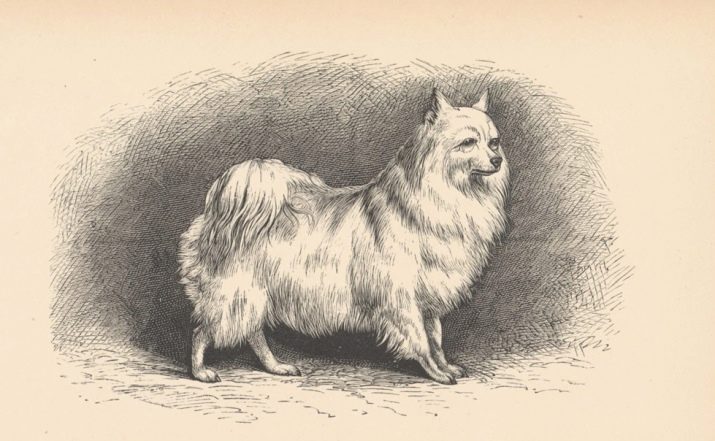
Images of the Greeks and Romans proved that the dogs were smaller here. Their skulls usually did not exceed 15 cm in size, the muzzle was relatively narrow, the nose was short. Some expression was also noticeable on the back of the head.
The Germans were confident in the need to maintain a standard weight (no more than 7 kg), and therefore only miniature representatives of the breed were selected for breeding. Gradually, these Spitz became smaller and smaller. By the way, it is also curious that their color, like weight, at one time depended on the region of breeding.
So, Germany gave a start to the formation of a separate line of Spitz, called German, although the signs were finally fixed already in England. Since that time, dogs have become popular with the royal nobility. At one time, Queen Victoria of England kept approximately 15 royal spitz breeds. It was from the Victorian era that they began to participate in exhibition events that had just appeared at that time.
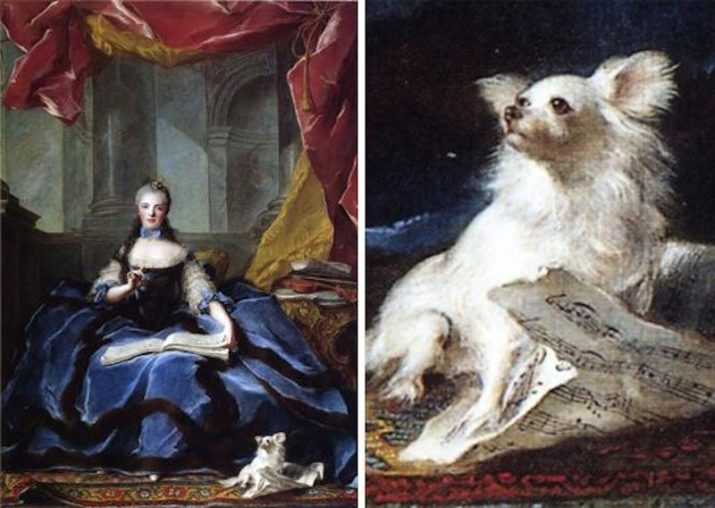
It is noteworthy that Queen Victoria adored ornamental Spitz breeds. She especially liked dogs, whose height at the withers did not exceed 22 cm. Today, such pets are considered the smallest among all the varieties of Spitz. They are not adapted to tedious loads and are rather companions, although they require a lot of time to maintain and educate.
A lot of interesting facts are connected with the history of the formation of the breed. For example, in the century before last, it was mainly women who were engaged in breeding certain breeds of Spitz. This is evidenced by the existing official breeder lists.
Moreover, it was women who initiated the appearance of the first nurseries, in which, in the early stages of their existence, animals of white and black colors were bred.
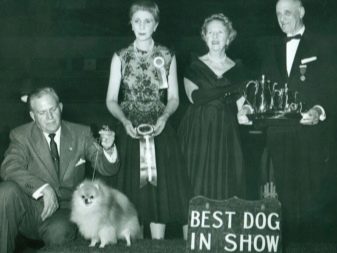

Description of the breed
Spitz have many varieties, which explains the difference in describing their appearance and character. However, they all descended from the so-called "peat" dog that lived in the Stone Age. At the same time, the size of the representatives of the Spitz breed can differ dramatically, as well as the weight. Some Spitz are large, others are typical representatives of "mimic" appearance and size, which is especially enhanced by the selection of the appropriate hairstyle or the so-called grooming.
Individual Spitz, as adults, weigh a little over 1 kg. Dogs of this breed develop on average up to 5-9 months. The difference in performance depends on the type of dog: for example, large pets take longer to grow up. However, it is generally believed that the period of active growth ends when the animal is 12 months old.
It was at this time that the males are already ready for mating. Dogs of this breed live for about 12-16 years, although the average period can be reduced due to various factors (for example, inadequate care and improper diet, the presence of pathological diseases or genetic disorders).

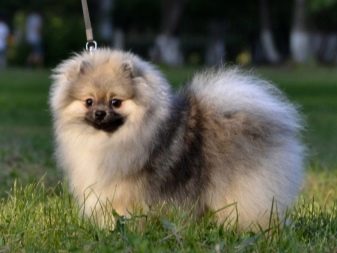
Babies can be born with a tiny weight: at the time of birth, it can be 90-120 grams. During growing up, the dog sometimes changes beyond recognition, becoming a charming furry friend. The size of the large Spitz is impressive: their weight can reach 22 kg with a height at the withers up to 55 cm. Today, the colors of the Spitz can be blue, sable, beaver and tricolor.
Spitz are crossed with dogs of other breeds, and mestizo, as a rule, inherit the best qualities of their parents. For example, a cross between a husky and a spitz made it possible to achieve the Pomsky breed, the mestizo spitz and chihuahua began to be called rush.
Average weight of Spitz (in grams) by month can be seen in the table.

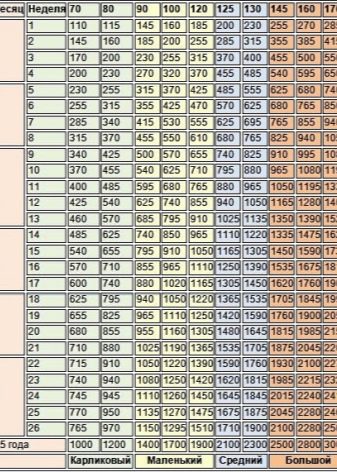
Appearance
As for the general standard, it has a number of its characteristic features. The classic adult Spitz, according to the established standard description, has a small head. From above, it may appear a little wide, but the front view proves that the shape of the muzzle in dogs is narrowed. The nose can be slightly flattened, but it must be narrow and small.
Its color, according to the standard, can be black or dark brown. The lips of pets are free from folds, tight-fitting. The eyes appear small against the background of the muzzle, can be set at an angle, the eyelids are almost always dark.
An individual that fits the standard should have 42 teeth.
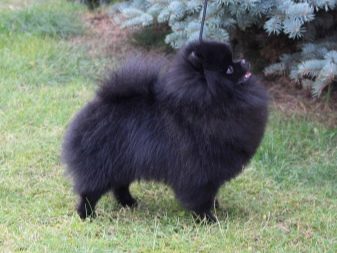
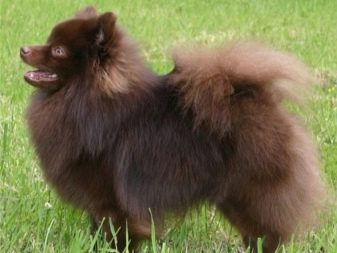
According to a general characteristic, the bite of the Spitz is scissor-shaped, the ears are small, set straight up. The neck is small, the back is short and straight, the croup is not sloping, rather wide and short. The color of the Spitz can be different, for example:
- black without any light markings;
- black and silver with a darker color at the ends of the hairs;
- pure white or with rare milk points;
- plain brown without markings;
- fiery red without pattern and spots of a different color.
However, regardless of the variety, the standard clearly sets out the requirements for wool. It should not curl, and the undercoat should always be straight, despite the fact that its length can be either short or long. The best Spitz dog is one with a straight coat and a thick undercoat.
Disqualification is given to dogs with an irregular bite, ungrown crown, eversion or volvulus of the eyelids, semi-erect ears and bright white markings.
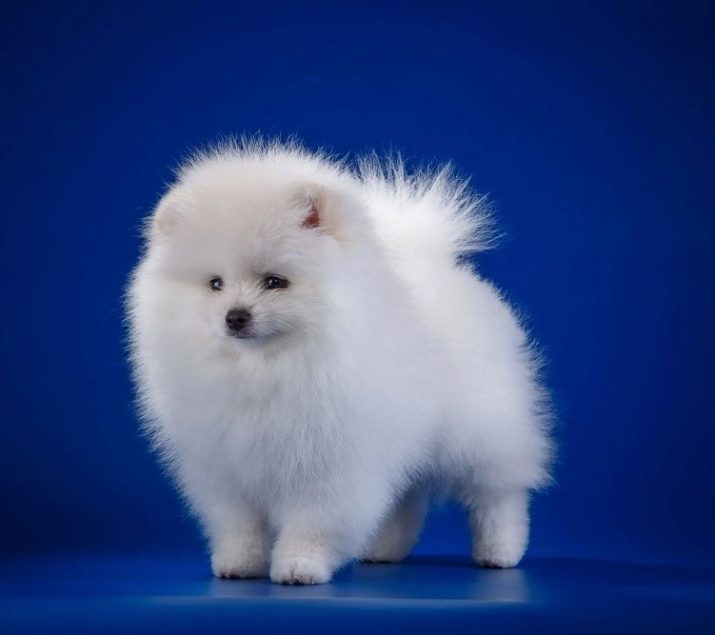
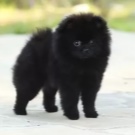

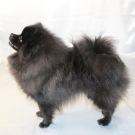
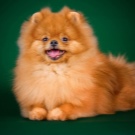

Character
Regardless of the variety, the breed feels big. Therefore, they often do not calculate their strength and chances, bullying up to larger dogs or cats. Despite this, they are very active and mobile. They are not characterized by boredom, and therefore they always respond to the attention of the owners if they notice that the owners are not averse to playing or taking a walk with them.
They will show a whirlwind of their emotions with loud barking, and small dogs prefer to scare away strangers to them.when they have doubts about their own victory in a conflict. Adoring the sound of your own voice is often the reason for the discontent of neighbors if the pet lives in an apartment building. The solution to the problem is training: in the process of training, the dog becomes less noisy.


Owners are often struck by the Spitz's energy and restlessness. Their vitality is enough for walks, games, learning and helping household members. An amazing quality of these animals is their understanding of the atmosphere in the house. Spitz can be companions, they feel the mood of the owners, they can become loyal friends to people of all ages, with the exception of small children.
However, dogs are completely defenseless against loneliness. If you do not pay enough attention to them, they yearn and literally get lost, not knowing where to direct their energy. Human affection and care are vital for them. Lack of attention can turn into mischief. Spitz need both physical and mental stress.
Despite the fact that the Pomeranian looks cute and friendly, the individual representative of the breed can afford to dominate weak pets.
In addition, some of the individuals are jealous. They need training in house rules and training. Without her, some funny dogs quickly turn into house tyrants.
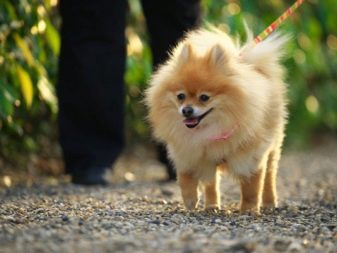

Varieties and features
The Spitz breed has many varieties. For example, the classification may be based on assigning a separate group by purpose. Based on this, dog handlers generally distinguish traction, hunting, herding and guard dogs. Moreover, most of the Spitz species can be called watchdog pets rather than hunters or shepherds.The only hunter can rightfully be called the Finnish Spitz.
Regardless of the variety and size, the Spitz have excellent hearing, and therefore they inform the owners of any danger with a loud and sonorous bark. Traction dogs include individuals capable of carrying loads, running in harness for a long time. This species includes the Samoyed Spitz (Samoyed), as well as the Norbottenspitz, although today they are rarely used for pulling teams.
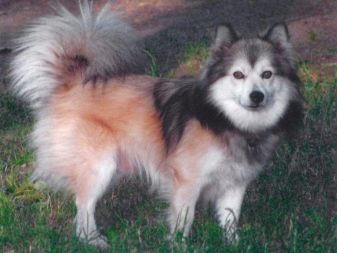
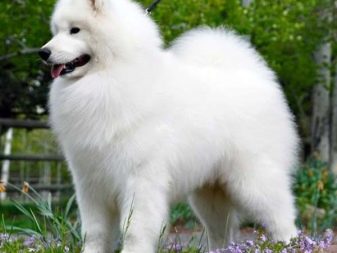
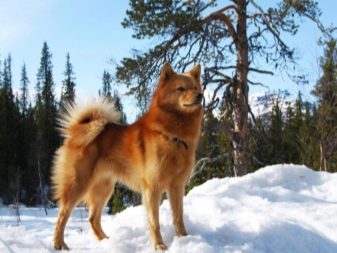

Also, conditionally, Spitz can be classified by size, dividing animals into miniature, small, medium and large pets. Each type of animal has its own differences, which is manifested not only in appearance, but also in character traits. This explains the different behavior of the dogs. As for the names, the Spitz have a lot of them. This breed includes dogs: Batak, Volpino (Italian), Keeshond (Wolfspitz), Kleinspitz (small Spitz), German large, medium Mittelspitz, Pomeranian (dwarf).
In addition, the breed includes the Samoyed, Finnish, Japanese, French, English, Lapland, Russian, and Scottish. Animals also differ in the type of wool.
Depending on the breed type, the pet can be long-haired or short-haired. Their undercoat is fluffy, but very thick, which complicates the care of the fur coat.

Tiny (mini spitz)
For example, dwarf breeds, reaching a height at the withers of no more than 22 cm, are distinguished by the greatest friendliness. They love to flatter their owners, despite the fact that they are decorative pets, they have a lot of courage and sometimes prove that they are not toys at all. At the same time, brave dogs with a clear voice weigh in the range of 1.5-3 kg. This line of varieties includes Pomeranian miniature dogs.
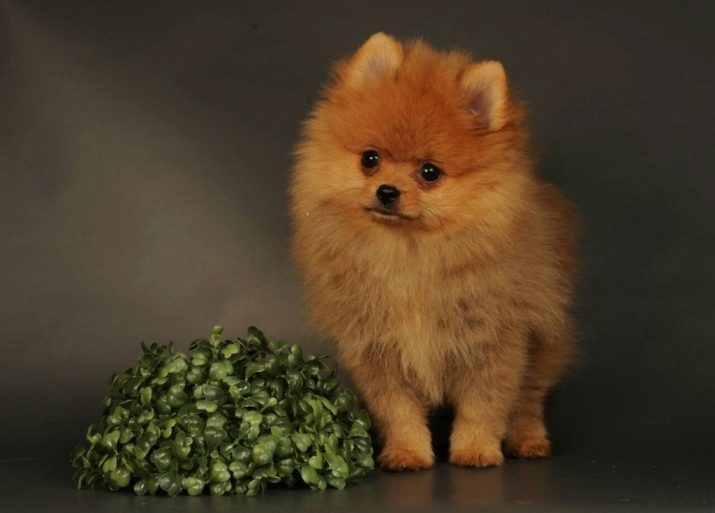
As for German breeds, then a separate category of dog handlers distinguishes the German Spitz or Wolfspitz into a separate, larger variety of dogs... Pomeranians are often confused with Germans, although the two types have clear external differences. For example, the key difference is size: the growth of the German variety can reach 35 cm or more. In addition, its muzzle is more elongated in comparison with the orange. The coat of dogs of two varieties also differs: in German brethren, it is coarser.
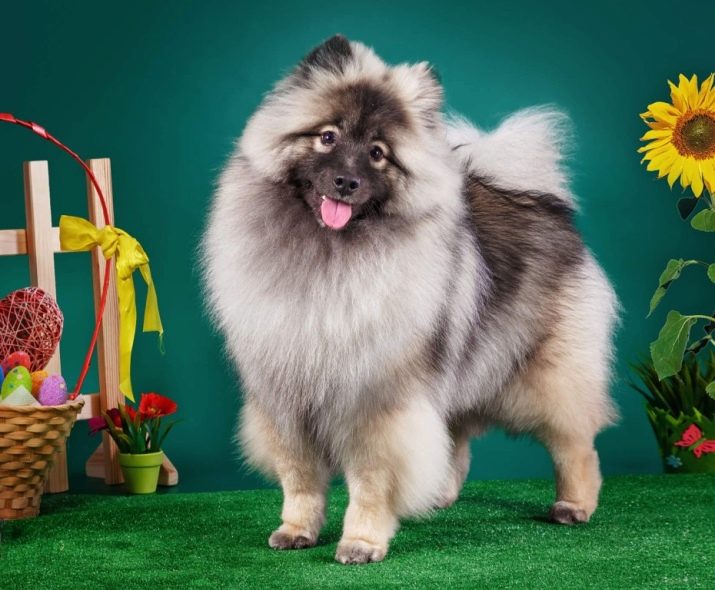
It is noteworthy that the Pomeranian Spitz are also different from each other: they have a different type of muzzle. It can be bearish. At the same time, it seems rounded, not elongated, and sometimes even somewhat flattened. Looking at such a dog, one gets the impression that it has full cheeks, a raised chin and eyes close to the nose.
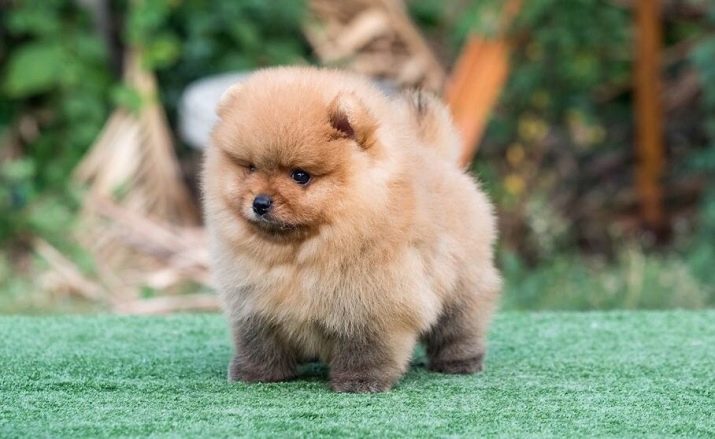
The fox type of muzzle is more elongated. With this shape, the chin of animals is elongated and narrow, the cheeks are fluffy, and the nose looks like a button at all. The toy face has its own differences, although it is somewhat like a bear. If you look closely at it, you will notice that this muzzle is flatter, and the differences relate to the position of the eyes. In the toy type, they are not so close to the nose and are set slightly higher.

Dogs of the miniature type have a wide variety of colors. For example, in nurseries you can buy bluish, white, red, sand, gray, brown, black puppies. Each color is unique in its own way. It is also surprising that miniature pets are able to quickly adopt some of the traits of their owners.
Some representatives of the breed are even able to imitate the behavior of their owners.
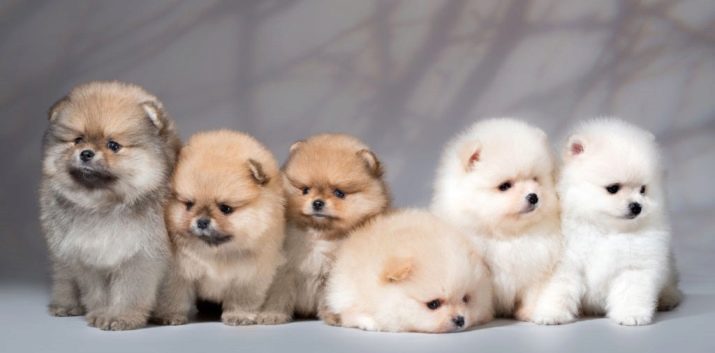
Small
This line of Spitz includes individuals with a height at the withers from 23 to 29 cm. These babies are called Kleinspitz. This also includes some Pomeranians, whose height is 28 cm (females - 26 cm). These are companion dogs that do not need vigorous physical activity and exhausting training. In addition, the Italian Volpino with a fox muzzle fits into these dimensions, the height at the withers of which usually does not exceed 28 cm and weighs up to 4.5 kg.


These dogs are distinguished by obedience, they are easy to train due to the good memorization of different commands. For all their decorativeness, they sense danger and can instantly change their mood if the situation so requires. For example, playfulness can be abruptly replaced by alertness and seriousness. It is worth noting that it is imperative for these dogs to get rid of excess energy, but at the same time, their short legs should not be subjected to prolonged stress.
These Pomeranians get along well with their same-sex relatives, as well as other animals living in the house. However, some representatives of the breed are very touchy and do not understand when they are being squeezed too much, and even more so by the wool. The Kleinspitz are very cheerful, but at the same time they are original. For example, they do not go into the hands of all people, they require a lot of patience in education and training.
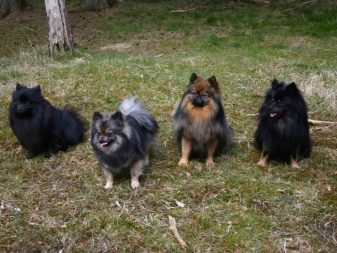
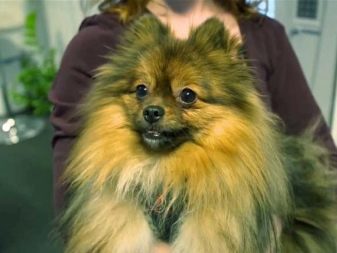
The weight of individual individuals of this line sometimes reaches 8-9 kg, oranges of this type weigh no more than 6 kg. These pets are characterized by a toy appearance, which is explained by the grooming of a fluffy coat. They always willingly come to the aid of the owner, they are able to cheer him up. In view of this, they are often turned on by elderly and lonely people.
Small dogs are distinguished by their easygoing temperament and quick-wittedness. They desperately need daily walks in the fresh air to maintain their health. They are non-aggressive, playful and active. In addition, these dogs, like mini-spitz, are mobile due to their size. You can take them with you wherever you go.
The life resource of these Spitz can reach 15-16 years.

Average
This category includes individuals with a height at the withers from 30 to 35-38 cm. These include Mittelspitz (immigrants from Germany), distinguished by their enormous energy and weighing up to 12 kg. They live an average of 14 years, but life expectancy can depend on care and compliance with the rules of maintenance (including hygiene and timely visits to the veterinarian). Like the Kleinspitz, the Middle Spitz are a German variety of a single breed.
At one time they were referred to as northern sled dogs. Their appearance differs from their small counterparts: they are not so compact, they have a more elongated muzzle and nose. It is somewhat similar to a fox, the dog's nose is dark, the coat is long, the tail is fluffy, bent upward in a half-ring. The color can be different (solid white, black, reddish, ash and brown).
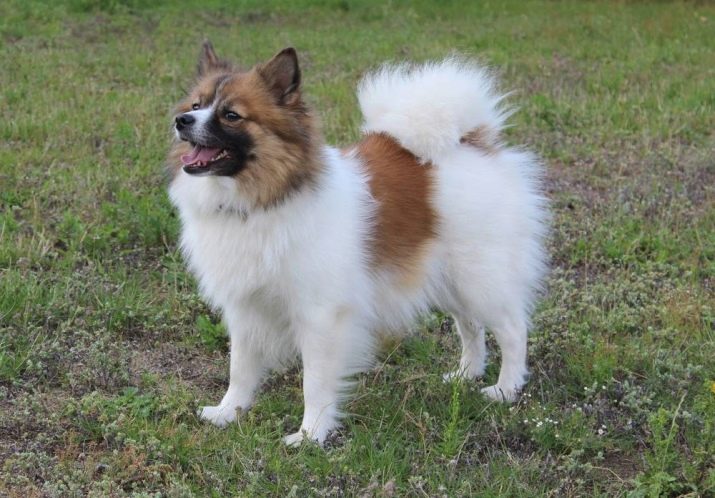
These Pomeranians need early socialization, which is due to the stubbornness faced by breeders who have missed training time. Often these Spitz resist training, refusing to follow the owner's commands. The owners have to show a lot of effort to avoid repetitive repetitions. It is important to ensure that the dogs do not get bored during training, because following the same commands seems boring and stupid to them.
In contrast to the previous varieties, physical activity is vital for these dogs. They are active and independent, with the right training they acquire an affection for the home and devotion to their owners. With them you have to be great inventors, because dogs literally love games, but not of the same type. It is undesirable to restrict these Spitz in walks and movements, since the unspent energy develops into aggression and unrestrained barking.
In comparison with other representatives of the breed, these dogs are jealous and do not tolerate competition in the struggle for the attention of the owner. Their degree of liveliness is lower than that of ornamental spitz: in some cases, dogs can take evil on other pets living in the house. They also differ in the texture of the coat, which affects the complexity of grooming.
The guard hairs of the coat are longer and coarser than the undercoat. It is soft, reminiscent of fluff.
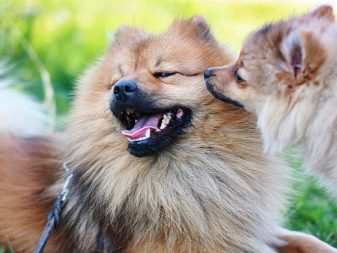
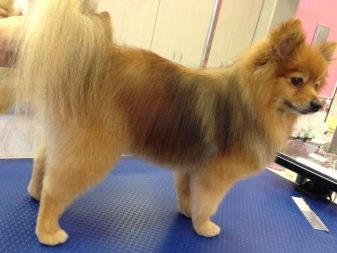
Large
Large Spitz breeds have their own characteristic differences in behavior and appearance. Their height at the withers can average from 42 to 51 cm, the height of females varies from 41 to 46 cm.This category of dogs includes the Grossspitz, who are descendants of northern shepherd dogs. They are classified as European German Spitz with a high degree of observation.
The color of these animals can be white, black, chocolate. At the same time, the standard clearly states that the color should not have marks or impurities of other shades. Outwardly, these dogs are not only larger than the previous ones, they are distinguished by a muscular physique and the presence of a long-haired fur coat. Unlike ornamental relatives, they are strong and require active physical activity.
This variety of Spitz is considered rare, in these dogs the head is wedge-shaped, it tapers towards the end of the nose, in proportion to the body. The ears of the grossspitz are always set, their teeth are white and, as a rule, strong.
Pets of this line have a good memory, which allows you to teach them many commands and instill an understanding of the rules set in the house and in communication.
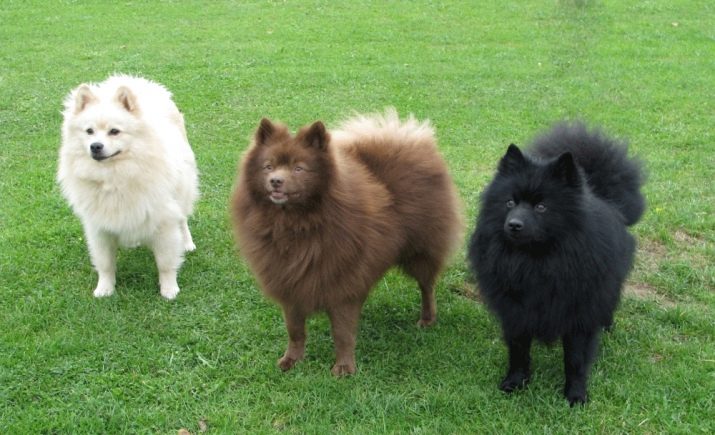
Large
The brightest representatives of this line are the smooth-haired Keeshondas, which are often called wolf dogs. The growth of these dogs at the withers is on average 55 cm, such a pet weighs about 30 kg. In fact, these are relatives of the German Spitz, but their homeland is the Netherlands. Of all the species, these dogs have the largest body dimensions.
They have long been used as watchmen and for hunting. Today they have not lost their flair, which is why some breeders take them with them to hunt. Dogs have an amazing appearance: they are distinguished by a dark nose and a characteristic coloration, similar to a wolf. These dogs can live both at home and outdoors. They have thick and long hair, which prevents the dogs from freezing even in the cold.

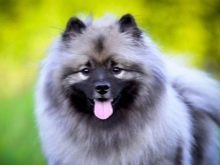
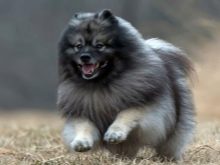
These dogs are clean and able to wash their faces on their own, like cats. They have a bright temperament: these Spitz are confident, sociable and independent. A Wolfspitz puppy is like a hurricane, but as it grows up it becomes calm and reasonable. At the same time, the dog's zest for life remains the same as it was in childhood.
During training, these pets do not put up with a cry: it is the reason that they lose any interest in training and training... Such a dog can learn as many commands as its circus cousin. Its life resource is on average 14-16 years.
However, you need to feed her correctly, since her body is prone to obesity.
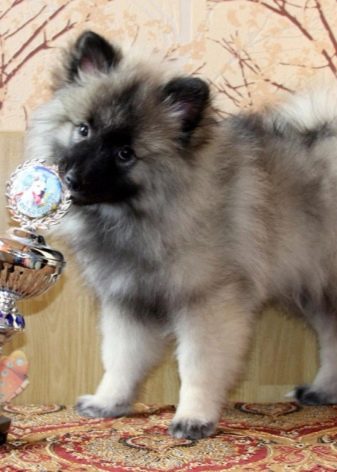

Advantages and disadvantages
Regardless of the variety, the Spitz has many advantages. For example, one of them is their lordly appearance. These dogs are unique, some of them resemble bear cubs, others resemble wolves. With proper care and proper education, they are a source of pride for the owners and take worthy places at exhibitions.
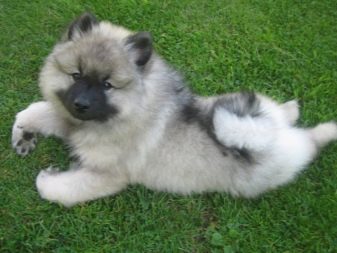
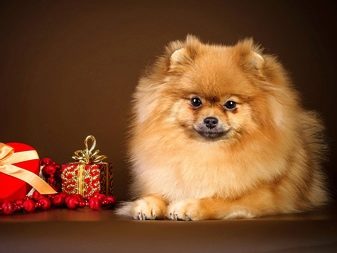
These pets are incredibly sensitive: they catch the intonation of a person's voice, and therefore understand how to behave in a given situation. For example, some representatives of the breed are able not only to play with the owners, but also to feel sorry for them. In addition, pets often adapt to the mood of a person, which not all animals do.
Their cheerfulness can sometimes inspire a person who is depressed. By the way, it is also interesting that the color of the dogs creates the effect of a smile. When you look at a pet, you get the feeling that a “ulybka dog” lives in the house. The animal is almost always friendly, it rarely has mood swings.
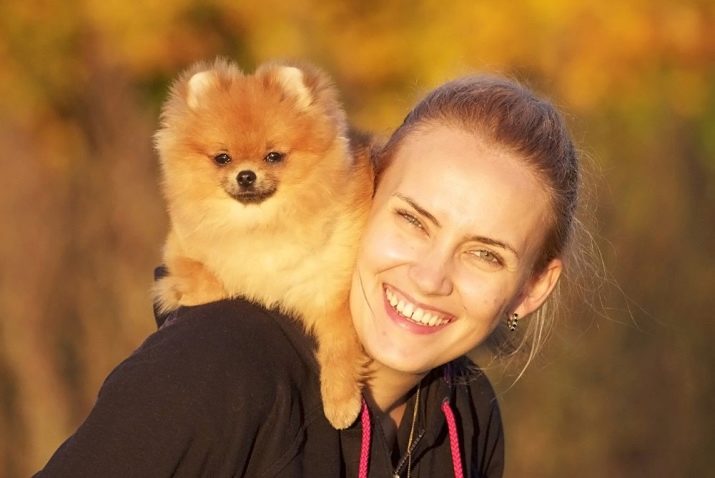
Some representatives of the breed are characterized by special cleanliness. Like cats, they lick their own fur several times a day. At the same time, they do not resist hygiene if they are accustomed to it from a young claw. They are grateful to the owners for their attention and care.
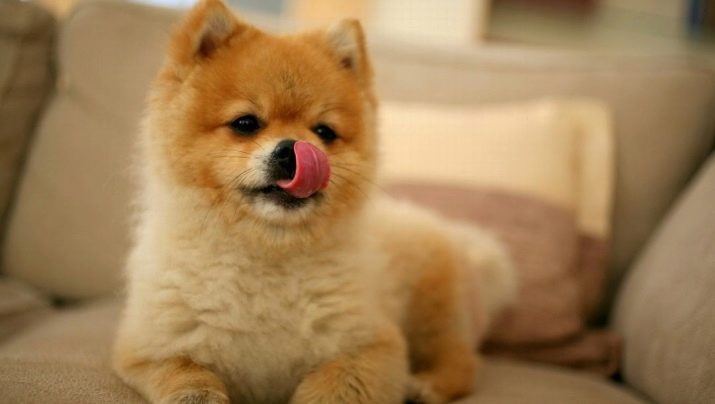
Spitz willingly accompany their owners, often show tolerance towards people, and some individuals manage to keep their emotions to themselves (in cases when they do not like a stranger). In general, their stock of friendliness and disposition can only be envied.They are adequate helpers and companions, which makes them suitable for owners of different social statuses.
However, with all the advantages, the Spitz also has disadvantages. For example, not every breeder is able to withstand the communication of a dog for a long time, which it shows through a cheerful and sonorous bark. If, at the same time, she lives in an apartment building, the walls of which are poorly insulated from noise, the owners of the home may have problems with their neighbors. Deafening barking can be heard on several floors.
An equally significant drawback is the predisposition to genetically determined anomalies and pathologies. For example, some Pomeranians do not lose their baby teeth. The change of teeth takes place with the help of a veterinarian who specializes in dentistry. Some individuals have an excessively deep root base, and therefore they can remain in the gums.
It is necessary to alleviate the condition of pets in specialized clinics.

In other animals, collapse of the trachea, patent ductus arteriosus, may be observed. In addition, dogs are prone to dislocation of the patella, as well as diseases such as cryptorchidism, endocardiosis, tartar, rhinitis, and chronic laryngotracheitis. Some representatives of the breed, like people, can develop cataracts. Due to their high jumping ability and fragile bones, dwarf Spitz are susceptible to injury.
Small puppies have a weak stomach, which is why the owner must select the food very carefully. In addition, both puppies and adult dogs have a predisposition to heat stroke and inflammation of the skin. It is worth noting such a nuance as active hair loss in Pomeranians. Hair loss sometimes leads to the fact that the Spitz becomes bald. This pathology is treatable, but the earlier the problem is detected, the better.
This is not to say that the care and maintenance of a Spitz is cheap. You have to invest in a bed, dishes, toys, vaccinations, routine examinations, food, care and bathing products.
In addition, from time to time you have to pay for grooming, in which the dog is brought into proper shape. This pleasure is not cheap, and the exhibition events, to which individual representatives of the breed are taken, are also expensive.

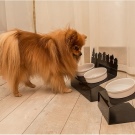
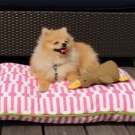
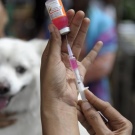
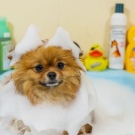
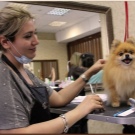
The common Spitz is very active with all family members, including children. However, if the children are still very young, it is undesirable to leave them alone with the pets, the reason for which lies in excessive energy. The dog may not calculate its own strength, knocking down a toddler who is just learning to walk. As for the type of owner, the Spitz is completely unsuitable for bum owners. These dogs are demanding of themselves, even the slightest violation of the grooming regime will turn into a problem.
It is important to note that some breeders consider Spitz dogs to be allergenic. During molting, pet hair settles on almost all things in the house. There is a lot of it, and therefore the number of allergens increases until the molt process ends. If the owner or his family members are not allergic to wool, this problem will not arise.

Reproduction and breeding
Breeding dogs of this breed is considered difficult, which is especially true for miniature varieties. Not all puppies are born according to the standard. In addition, not every individual is allowed for breeding due to the inconsistency of its class. It is worth noting the fact that often Spitz males are not at all interested in females: they often show indifference towards them.
However, the Spitz boy, who has learned mating, constantly strives for mating, which is reflected in his behavior. He is in constant search of a pair, becomes restless, which can develop into aggression. For breeding, it is important to observe a number of conditions, among which the size of both partners is important.
For example, the weight of the male should be slightly less than the weight of the female.This will ensure that puppies of the right and the same size are born.
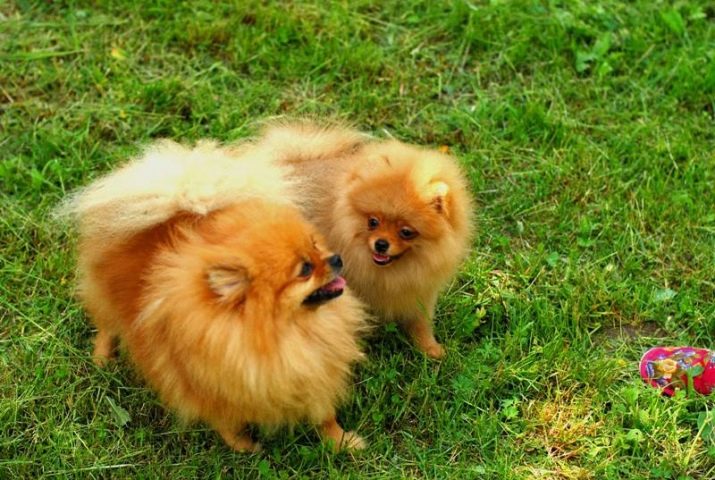
This rule does not apply to German Spitz. It is not so important here whether the female is smaller or the male. But if you breed pets of more than one variety, puppies will be born, the appearance of which will differ from the true Germans.
Spitz knitting has its own nuances. For example, the female must be ready for her, which means that you need to find the moment during her estrus, which usually lasts within 22 days, divided into two stages. It is useless to let a male dog near a female in the first half of estrus (forerunner), which lasts an average of 5 to 12 days. At this time, the behavior of the dog is aggressive, and therefore it does not admit its partner.
The heat itself, lasting an average of two weeks, is more suitable for mating. Dogs are left in an empty room, removing everything from there that might distract their attention. If the male already has experience of communicating with the female, there are no problems with mating. During the period of estrus, a male dog is mated with a female Pomeranian twice. Pregnancy in dogs lasts approximately 58 to 64 days.
Long hair can complicate knitting. Therefore, before mating, she is cut off by each partner in the genital area. This aspect is especially important if mating for two partners occurs for the first time. When breeding, it is important to take into account the age of the partners.
Females who are not yet a year old should not be allowed to see her. Their readiness for breeding is determined by the age of 2 years, while males are ready to mate a year.
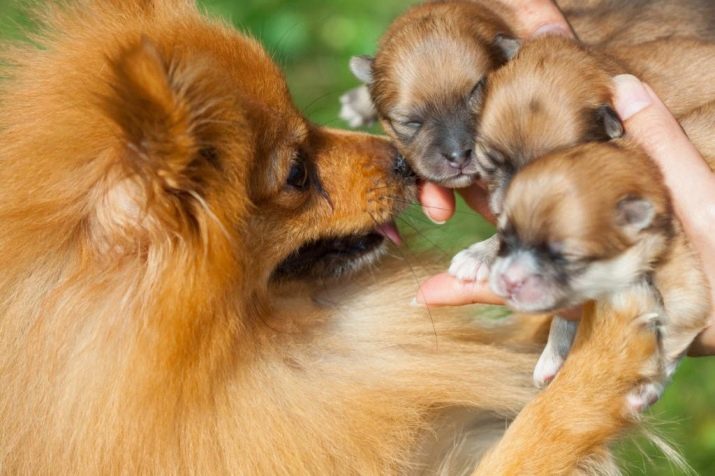
How old do they grow up?
Spitz grows differently depending on the variety. It is believed that dogs are fully formed by 2-3 years. Moreover, each stage of development has its own nuances. For example, in puppies up to a month old, the skin is still visible, the parts of the body, which can be used to determine the future color of the coat, do not have the necessary proportions.
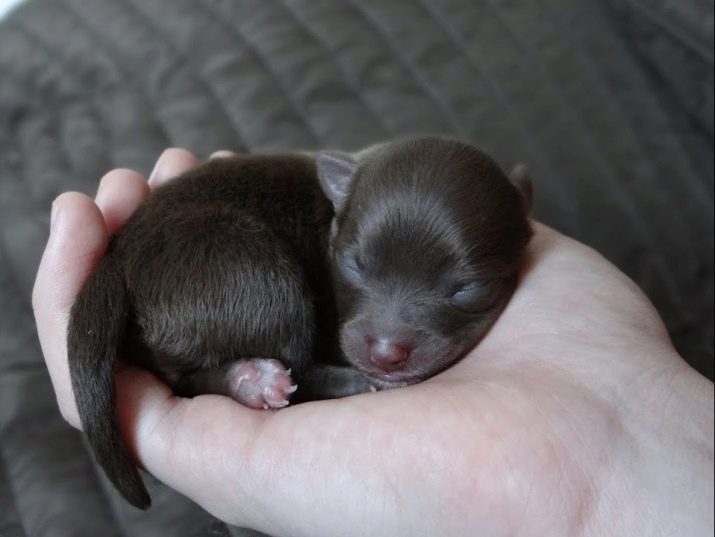
A puppy is born blind, newborn babies open their eyes at the age of two weeks, their hearing appears in 2.5 weeks from the moment of birth. At the beginning of the second month, milk teeth erupt in small pets, and therefore they have to buy toys for them and clean up valuable things. At 2 months, the baby develops character traits.
At 3-4 months, he learns his first molt in his life, in which children's fluff is replaced by real adult wool. At this time, the puppies go bald, and therefore become very ugly. At six months, molting can continue, at this time the teeth are already completely changing. At 9 months, the pet has reached the age when it can take part in exhibitions. His fur coat was completely renewed, and he himself became a dog with an attractive appearance.
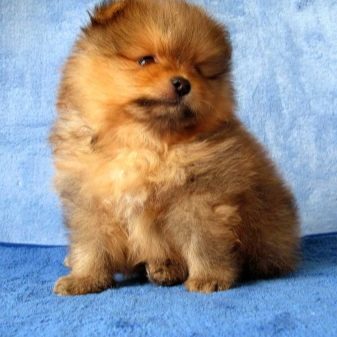
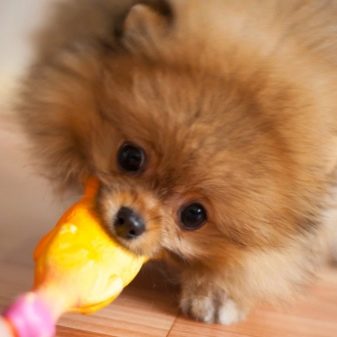
Content
Keeping a Spitz means following the rules of hygiene, training it, timely and correct feeding, walking, as well as preventive examination by a veterinarian and vaccination.
Care
Particular attention has to be paid to thick wool: it quickly gets tangled if the owner skips the combing procedure. For these dogs, it is necessary to choose the right comb not only, they also need a slicker or furminator, through which the owner can rid his fluffy pet of the dead hair that dogs wear for months.
Pets' hair, given that they shed profusely, must be combed constantly and often, picking up a furminator with the proper frequency of teeth and the width of the comb.
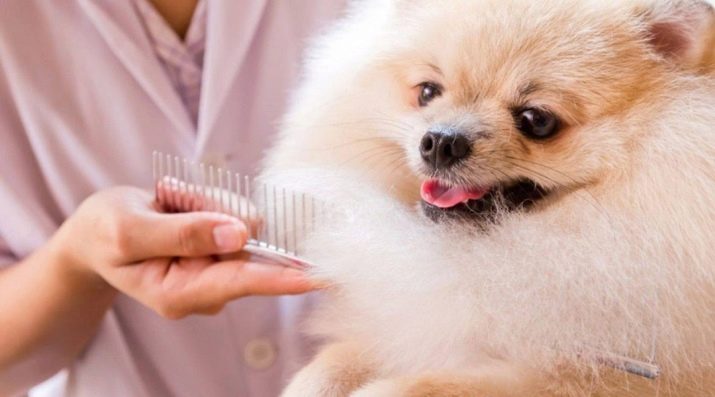
Ears, eyes and teeth should be brushed regularly. In addition, dogs need nail hygiene: they are cleaned of accumulated dirt and trimmed in a timely manner. Dogs should not be bathed often; for washing, you need to purchase special shampoos and conditioners, which will make the coat silky and make it easier to comb. It is undesirable to wash your pet more than once a month.
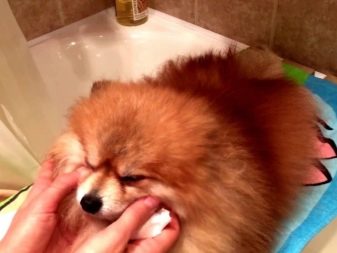
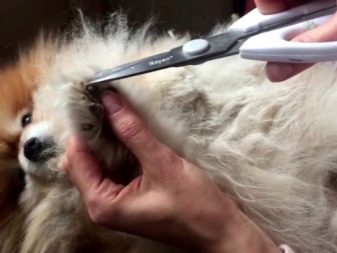
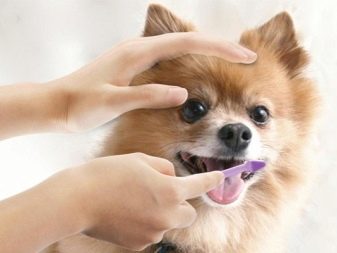
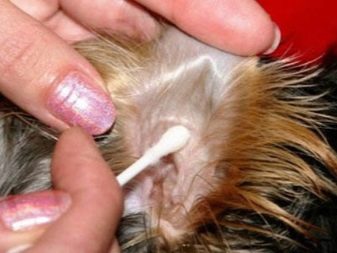
With the appearance of a puppy in the house, you need to take care of buying a comfortable bed and carrier, which will protect the baby's fragile bones in the first months of his life in the new home.Your own bed will allow your pet to understand its place, which is the first and key rule of upbringing. If he is invited to a bed or upholstered furniture, such a dog is doomed to misunderstanding the boundaries and rules established in the house.

As you grow older, you will have to buy a muzzle, which is especially important for representatives of a large breed. So that during the period when the dog's teeth are changing, she does not gnaw everything, she gets her own toys. It is also important to take into account the fact that the Spitz should have his own dishes. This is not due to disgust, but seeing the dishes on the table, similar to the one from which the pet eats, he will not have the understanding that this is not his place to eat.
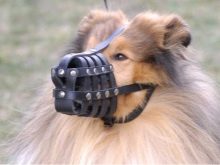

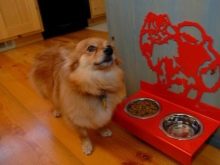
Walking is a must, and you will have to accustom your pet to the collar from an early age. Due to their frequency and regularity, it will be possible to quickly train the dog to toilet on the street. The collar must be selected according to the age and size of the pet. In rainy weather, decorative dogs need to wear protective overalls.
In the heat, you cannot walk animals, it is also important to ensure that they are not in the sun when walking.
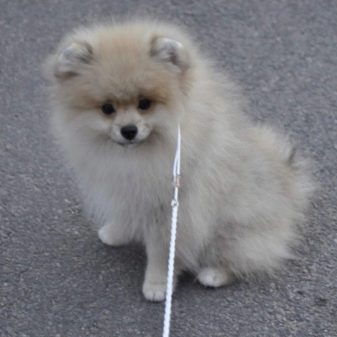
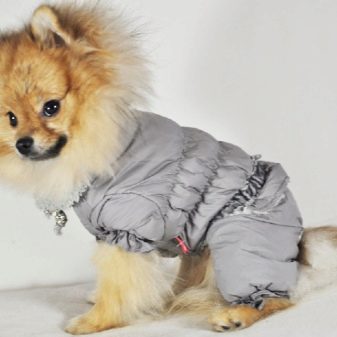
The diet
The nutritional diet of dogs should contain all useful vitamins and minerals. Otherwise, the animal's immunity will be weakened. Ideally, these dogs need natural food: they eat porridge, boiled meat, fish and even vegetables well. Raw fish is not suitable for them, as well as flour (bread or pasta). From flour dogs puffiness, they have intestinal upset.
You cannot treat Spitz with sweets or sugary foods. This provokes the development of caries and is a factor provoking obesity. It is impossible to include legumes and potatoes in a nutritious diet: not every representative of the breed can handle such food with a stomach. However, cottage cheese is useful to them, as well as boiled liver and heart.
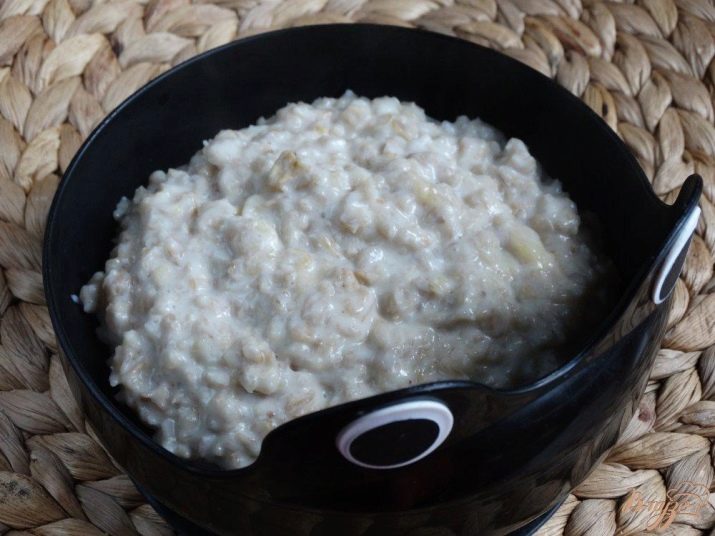
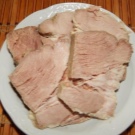
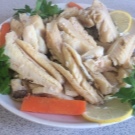
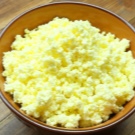

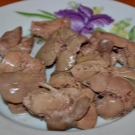
The meat consumed should be lean. Dogs should be given carrots, fresh fruits, dried fruits, kefir, buckwheat and rice. They cannot eat anything fatty or smoked. Sausage, chips and similar food is unacceptable to them. The frequency of food intake is 5 times a day for a small puppy. At the age of 8 months, the dog should eat no more than twice a day.
Regardless of the number of meals, the dog should always have a bowl of fresh water. You do not need to pour liquids into it that households do not drink.
Neither tea nor milk from the dog's store is needed, and milk will even harm her, given its modern origin and dubious composition.
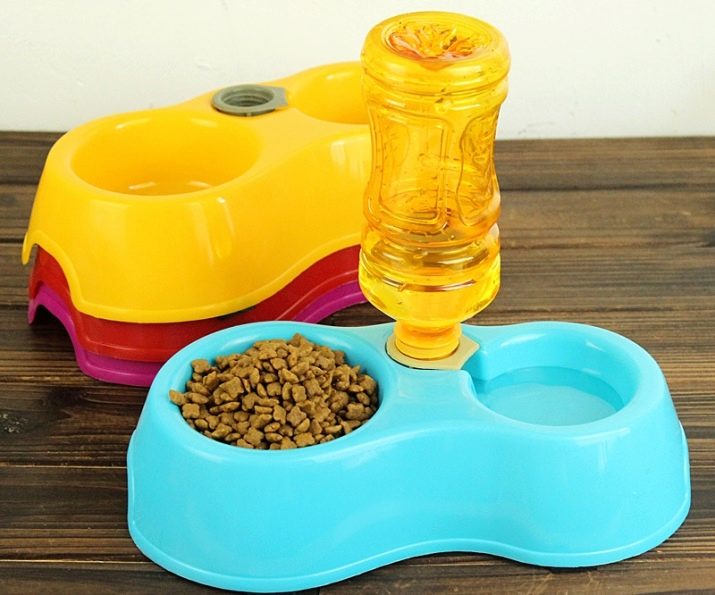
Nuances of training
You need to train your pet as soon as it gets comfortable in a new place. If you let the situation take its course, the cute dog will begin to dominate the owner, doing everything that comes into her head (up to the point that she can allow herself to mark in the apartment). The owner will not only have to teach the pet different commands, but also wean those addictions that the puppy could have acquired in the kennel.
For example, some individuals will have to wean themselves from biting, while others will have to bark loudly and for a long time. Socialization and training sessions should be played in a playful way. Otherwise, the dog will get bored and stop paying attention to the need to complete this or that task. The puppy should not be allowed to get used to chewing on the objects he liked: he must understand that he has special objects for this.
Dogs react to the intonation of the owner's voice. They quickly understand when and for what they are praised, and therefore try to obey their owners.
They understand their name, being puppies, but the psychological portrait and behavior of dogs is completely dependent on the person. There should not be any screaming during upbringing and training: it will not give any result other than resentment and apathy.


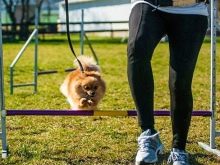
Owner reviews
Spitz dogs are favorites of breeders, as evidenced by the reviews of the owners left on information portals.The comments indicate the active life position and restlessness of the representatives of this breed. Spitz is liked by the owners for their spontaneity and positive attitude; they are loyal, loyal and moderately cunning. As pointed out in the comments, these dogs live up to the name "companions".
They are really able to cheer up and save the owners from the blues. According to breeders, dogs have an open character, they can adapt to the rhythm of life of their owners, despite a certain love of freedom. They can be kept both in apartments and in private houses. They are very fond of the game of tug of ropes, catch-up, they like to play with toys, not to give them away.
As for leaving, the owners are unanimous in its complexity. The Spitz's woolen coat is quite thick, many have to take companions to professional groomers in order to bring their coat into a decent appearance. According to the owner's assessment, it is prone to tangling and contamination. During the molting period, it has to be combed out daily using a furminator.
Interesting facts about Spitz in the video below.







































Pomeranian Spitz names are Max and Mitya.
We have two Spitz, one is called Max, and the other is Dandelion. Max is a Miniature Spitz and Dandelion is German.